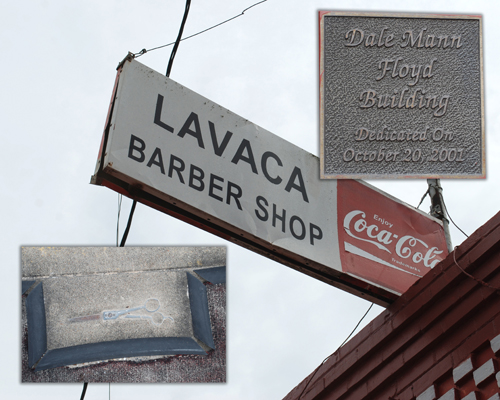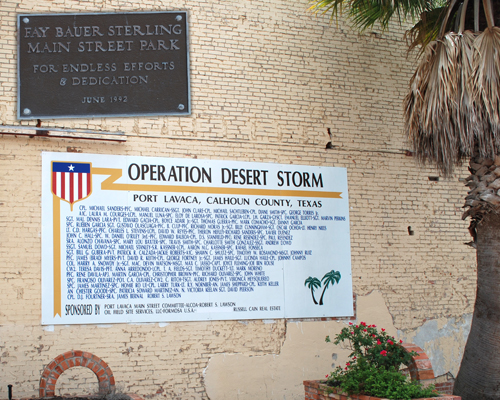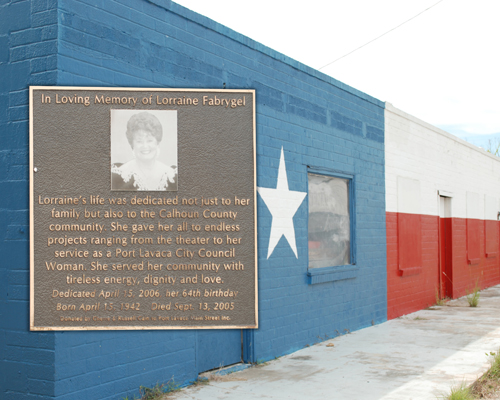
This building is located at 108 South Guadalupe. I found the scissors which were placed in front of the doorstep unique.
History Lesson
Since the last issue, I’ve found myself often strolling down Main Street (otherwise known as US 87) wondering about Port Lavaca’s history. Each stroll I take, I stumble upon another plaque, sign or emblem. It’s difficult for me to understand how the puzzle pieces form this coastal town without a history lesson first.
After several hours and a visit to the Calhoun County Library, I had a better grasp of the fishing community. Read on… I found it interesting that Port Lavaca and Indianola have fought for the county seat for so many years.
Port Lavaca, was founded in the aftermath of the Linnville raid of 1840, a Comanche attack that swept through Victoria. The Linnville raid of 1840 is said to have been one of the most terrifying Comanche attacks. Following the raid, in 1841, the town was named La Vaca, Spanish for the cow, and was laid out by 1842. It was later incorporated on two occasions as Port Lavaca. The town’s economy rests on manufacturing, seafood, agriculture and livestock, construction, mineral extraction, and tourism.
Port Lavaca Timeline
● In 1846, Calhoun County was established, Lavaca became the county seat.
● On September 5, 1850, The San Antonio and Mexican Gulf Railroad was chartered.
● In 1852, with the advantage over Lavaca of a deepwater port at nearby Powderhorn, Indianola became the county seat.
● In 1858, five miles of rail road track were put into operation.
● In 1861, twenty-three additional miles were completed into Victoria.
● On October 31 and November 1, 1862, federal gunboats bombarded the port, but the city, defended by two waterfront batteries, did not surrender, and the gunboats withdrew.
● In December 1863, Lavaca was occupied by Federal troops.
● In April 1864, Lavaca is voted to the county seat.
● In September 1865, after the end of the war, Indianola again became the county seat.
● In November 1886 Lavaca once again became the county seat.
● In 1887, Lavaca’s railroad connection with the track to Victoria was restored.
● About 1887, the community began to be known as Port Lavaca.
● In 1909, Port Lavaca incorporated as a general-law city.
● In 1913, the section of the Gulf Intracoastal Waterway below Galveston was completed.
● In November 1916, the city went bankrupt.
● In November 1919, Port Lavaca incorporated again as a general-law city.
● In 1920 a seawall was completed. The seawall was designed to protect Port Lavaca from high water and erosion.
● In 1928, Port Lavaca’s was leading the nation in the amount of seafood shipped.
● In 1934, natural gas was discovered near Port Lavaca.
● In 1935 passenger train service was discontinued, in addition, oil was discovered.
● In the late 1940s, Aluminum Company of America (Alcoa), Union Carbide, Du Pont, and Formosa in Point Comfort were established.
● In 1961 Hurricane Carla, a Category 4 hurricane struck the Texas coast, becoming one of the most powerful storms to ever strike the United States. The original causeway was seriously damaged.
● In 1965 the Matagorda Ship Channel was completed to Point Comfort.
● In 1985 a celebration marked the 300th anniversary of La Salle’s landing
Population
● In 1850 – white population of 231/slave population of 84
● In 1860 – white population of 526
● In 1870 – white population of 429/”colored” population of 339
● In 1880 – 100
● In 1890 – 365
● In 1900 – 800
● In 1910 – 1,699
● In 1920 – 1,213
● In 1930 – 1,367
● In 1940 – 2,069
● In 1950 – 5,062
● In 1960 – 8,864
● In 1970 – 10,491
● In 1990 – 10,886
● In 2000 – 12,035
● In 2010 – 12,248
I am on a mission to find out more about the buildings that make up downtown Port Lavaca. I have a slew of questions after exploring the nine blocks surrounding East Main Street. I’ve included photos which I’ve taken during my “Photo Walks”. Till next time!


